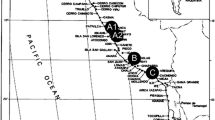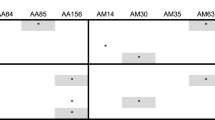Summary
Crossability within Ipomoea section Batatas is complex because of genetic, cytogenetic and physiological interactions. This complexity is responsible for the fact that knowledge about phylogenetic relationships within this section remains preliminary. Between 1988 and 1991, studies of planting, pollination and evaluation of progenies were carried out at the facilities of CIP in La Molina and San Ramon, Peru. Self-compatibility was found in nine diploid species. Self-incompatibility was found in diploid I. trifida, tetraploid I. tiliacea and both tetraploid and hexaploid I. batatas. Sexual compatibility is though to be related to a multiallelic sporophytic incompatibility system which is expressed in the stigmatic papillae. Altogether, 4,162 cross pollinations were made between 11 species and 76 interspecific combinations of 110 possible combinations in a diallel 11×11 design. From these 76 interspecific combinations only 38 survived, and in these crossability (= proportion between number of fruits harvested/pollinations made) ranged from 0.01 to 1.00 at La Molina. At San Ramon, 11 out of 17 cross combinations were successful, and in these crossability ranged from 0.01 to 0.71. Crossability appeared to be influenced by latitude which is related to flowering synchrony. The early death of seedlings is hypothesized to be related to a genomic imbalance between embryo and endosperm. Maternal effects were found in crosses between diploids and tetraploids which produced triploid and diploid offspring, and in crosses between hexaploids and diploids which gave rise to hexaploid offspring. This study shows that I. trifida and I. x leucantha may act as “bridge species” for gene flow from wild Ipomoea species to the genepool of the sweetpotato.
Similar content being viewed by others
References
AbelW.E. & D.F.Austin. 1981. Introgressive hybridization between Ipomoea trichocarpa and Ipomoea lacunosa (Convolvulaceae). Bulletin of the Torrey Botanical Club. Vol. 108(2): 231–239
AustinD.F. 1978. The Ipomoea complex-I. Taxonomy. Bulletin of the Torrey Botanical Club 105(2): 114–129.
Austin, D.F. 1988a. The Taxonomy Evolution and Genetic Diversity of Sweet Potatoes and Related Wild Species. In: International Potato Center 1988. Exploration, Maintenance, and Utilization of Sweet Potato Genetic Resources, Proc. Planning Conf., Centro Internacional de la Papa, Lima Peru, pp. 27–59.
AustinD.F. 1988b. Nomenclatural Changes in the Ipomoea batatas complex (Convolvulaceae). Taxon 37(1): 184, 185.
AustinD.F. R.K.Jansson & G.W.Wolfe. 1991. Convolvulaceae and Cylas: a proposed hypothesis on the origins of this plant/insect relationship. Tropical Agriculture (Trinidad) Vol. 68(2): 162–170.
BohacJ.R., D.F.Austin & A.Jones. 1993. Discovery of wild tetraploid sweetpotatoes. Economic Botany 47(2): 193–201.
Freyre, R.Y. 1989. Produccion de Hexaploides Sinteticos de Ipomoea trifida (H.B.K.) G. Don. Thesis, Ms C. Universidad Nacional Agraria, La Molina, Lima, Peru. pp. 180.
Iwanaga, M. 1988. Use of Wild Germplasm for Sweet Potato Breeding. In: International Potato Center 1988. Exploration, Maintenance, Utilization of Sweet Potato Genetic Resources. Proc. Planning Conf. Centro Internacional de la Papa, Lima Peru. pp. 199–210.
JonesA. & M.T.Deonier. 1965. Interspecific crosses among Ipomoea lacunosa, I. ramoni, I. trichocarpa, and I. triloba. Botanical Gazette 126(3): 226–232.
KobayashiM. & T.Miyazaki. 1976. Sweet Potato Breeding Using Wild Related Species. Proceeding of the Fourth Symposium of the International Society for Tropical Root Crops. CIAT, Cali, Colombia. pp. 53–57.
KobayashiR.S., J.C.Bouwkamp & S.L.Sinden. 1994. Interspecific hybrids from cross Incompatible relatives of Sweetpotato. Euphytica 80: 159–164.
Kokubu, T. & M. Sato. 1988. Isolation and Culture of Petiole Protoplasts of Sweet Potato, Ipomoea batatas (L.) Lam. and its Related Species. Memoirs of the Faculty of Agriculture Kagoshima University 24: 83–89.
Lu, Shu-yun, T. Kokubu & M. Sato. 1987. The Study on Promoting the Crossability between A and B Group in the Batatas Section of Ipomoea. pp. 1–16 (Unpublished).
MartinF.W. 1970. Sterility in Some Species Related to the Sweet Potato. Euphytica 19: 459–464.
MartinF.W. & A.Jones. 1972. The species of Ipomoea Closely Related to the Sweet Potato. Economic Botany 26(3): 201–215.
MartinF.W. & S.Ortiz 1967. Anatomy of the stigma and style of sweet potato. New Phytologist 66, 109–113.
McDonaldJ.A. & D.F.Austin. 1990. Changes and additions in Ipomoea section Batatas (Convolvulaceae). Brittonia 42(2): 116–120.
Nishiyama, I. 1982. Autohexaploid Evolution of the Sweet Potato. In: Sweet Potato-Proceedings of the First International Symposium, Asian Vegetable Research and Development Center. R.L. Villareal and T.D. Griggs (ed.). pp. 263–274.
NishiyamaI., T.Miyazaki & S.Sakamoto. 1975. Evolutionary Autoploidy in the Sweet Potato [Ipomoea batatas (L.) Lam.] and its Progenitors. Euphytica 24: 197–208.
OracionM.Z., K.Niwa & I.Shiotani. 1990. Cytological analysis of tetraploid hybrids between sweet potato and diploid Ipomoea trifida (H.B.K.) Don. Theoretical and Applied Genetics 80: 617–624.
Orjeda, M.G. 1990. Desarrollo y Uso de Hibridos Interespecificos entre Ipomoea batatas Lam. (2n=6x=90) e I. trifida (H.B.K.) G. Don. (2n=2x=30) como Probadores de Especies Silvestres Diploides y Tetraploides. Thesis Ms. C. Universidad Nacional Agraria, La Molina, Lima, Peru. pp. 195.
ShiotaniI. & T.Kawase. 1987. Synthetic Hexaploids Derived from Wild Species Related to Sweet Potato. Japanese Journal of Breeding 37(4): 367–376.
ShiotaniI., S.Yoshida & T.Kawase. 1990. Numerical Taxonomic Analysis and Crossability of Diploid Ipomoea Species Related to the Sweet Potato. Japanese Journal of Breeding 40(2): 159–174.
Teramura, T. 1979. Phylogenetic Study of Ipomoea Species in the section Batatas. Memoirs of the College of Agriculture (Kyoto University) (114): 29–48.
Xue, Q.H. 1988. Exploration and Utilization of Exotic Ipomoea Wild Germplasm in China. In: Agrobiological Genetics and Physiology Institute, Jiangsu Academy of Agricultural Sciences, Nanjing, Jiangsu 210014, The People's Republic of China. Workshop on Sweet Potato Improvement in Asia. Trivandrum, India, October 24–28, 1988.
Author information
Authors and Affiliations
Rights and permissions
About this article
Cite this article
Diaz, J., Schmiediche, P. & Austin, D.F. Polygon of crossability between eleven species of Ipomoea: section Batatas (Convolvulaceae). Euphytica 88, 189–200 (1996). https://doi.org/10.1007/BF00023890
Received:
Accepted:
Issue Date:
DOI: https://doi.org/10.1007/BF00023890




